l. - Abbreviation for liter.
labyrinth - Although sometimes used as a synonym for "maze," a labyrinth is classically a single (unicursal) pathway that leads physically to the center of a linear pattern and then back out by simply reversing direction on the same path. In a maze there are invariably riddles to be solved — dead-ends abound. Labyrinths have been known to the human race for over 3,500 years, conjuring up such images as the ancient Greek myth of Theseus and the Minotaur, confined in a labyrinthine hallway at Knossos. Labyrinths have been thought to hold spiritual meanings in various cultures. They have been used as solar and lunar calendars in others. In Arizona, in the American Southwest, the Hopi use the form of a labyrinth in their religious symbolism, and the Tohono O'odham "Man in the Maze" is a "seven-circuit" labyrinth, a part of this native people's creation myth. Metaphorically, "labyrinth" or "labyrinthine" might signify a thing that is highly intricate or convoluted in character, composition, or construction.
(pr. LA-bə-rinth)
Examples:
![]()
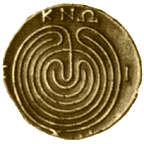
The mythical labyrinth on a coin from ancient
Crete. See numismatics.

Georg Andreas Böckler, n.d., Author;
Nuremberg : [s.n., 1664], Publisher Nuremberg, Architectura Curiosa Nova : Das ist, neue ergotzliche
Sinn und Kunstreiche auch nutzliche Bau- und Wasser-Kunst ..,
[s.n., 1664], printed book; 4 parts in 1 volume: 231 engraved plates;
34 cm, Metropolitan Museum of Art, NY.
Illustrated:
castle and gardens at Altenberg, Meissen from Architectura
Curiosa Nova.

France, Labyrinth in the Nave of Chartres Cathedral,
c. 1221, intarsia in a cruciform design.
Perhaps the earliest still-existing Christian
labyrinth is in the fourth-century basilica
of Reparatus, at Orleansville, Algeria. Medieval
pilgrims, unable to travel to Jerusalem, mostly journeyed instead
to holy sites within Europe.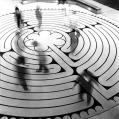 In many cases the actual destination was a labyrinth of paving
stones laid in the floor of the nave
of a great Gothic
cathedral. For some pilgrims,
reaching the center of such a labyrinth symbolized arriving at
the Holy City itself.
In many cases the actual destination was a labyrinth of paving
stones laid in the floor of the nave
of a great Gothic
cathedral. For some pilgrims,
reaching the center of such a labyrinth symbolized arriving at
the Holy City itself.
This is a reduction of the Chartres labyrinth
in an American church, where it is used as a stimulus to meditation.
[or dizzyness?! Could this be related to the spinning of swings,
or the whirling of dervishes?] See inlay.
Also see game theory, meander, and Native American art.
lacquer - The term popularly used for some commercially
prepared clear or pigmented
varnishes derived largely from
cellulose in a vehicle
of fast drying solvent, available
in hardware stores. Its commercially available solvents are called
either lacquer solvent
or lacquer thinner, and may contain acetone,
methyl acetate, or banana oil.
(pr. LAK-ər)
Also see chinoiserie, Duco, oriental lacquer, paint, polyurethane, resin, shellac, and toluene.
lacquer, oriental - A material for a kind of sculpture in which layers are built up, often on a base of silk around a model of another material, typically plain or carved wood. When hard, those carefully cured layers can be carved. Also, used as a varnish, it gives any surface it covers a hard, highly polished finish. It is found on items imported from Asia, but is rarely available for use in the West. Oriental lacquer is produced from the resin (sap) of certain trees in the Far East (in China and Japan this tree is a sumac, Rhus vernicifera, aka Rhus verniciflua), and can be used on many different materials. Lacquer can carry several pigments, but red, black, or a combination were used most frequently. Lacquer has extraordinary adhesive qualities; once cured, it is virtually impervious to moisture, alcohol, food acids, or decay.
(pr. O-ree-EN-təl LA-kər)
Examples of oriental lacquer:

China, Tea bowl stand, Southern Song
dynasty (1127-1279), brown lacquer on wood
and fabric, Asian Art Museum, San Francisco, CA.

China, Seven-lobed platter with scene of children at
play, Yuan dynasty
(1279-1368), 14th century, carved
red lacquer, diameter 21
7/8 inches (55.6 cm), Metropolitan Museum of Art, NY. See Chinese art.

Japan, Stationery
box, Momoyama period
(1568-1615), early 17th century, lacquer,
with sprinkled gold decoration
in Kodai-ji style, inlaid
with gold and silver foil,
height 8 1/4 inches (21 cm),
width 17 15/16 inches (45.6 cm), Metropolitan Museum of Art,
NY.

China, Lacquer Box, 1735-1796, wood,
carved lacquer, Hermitage Museum, St. Petersburg, Russia. On
the lid is a large "Chun" (spring) character with a
small figure of the
God of Longevity in a circle.

Seraphin Soudbinine (French, 1870-1944),
designer, Jean Dunand (French, 1877-1942), designer, "Fortissimo" Screen, 1925-26,
lacquered wood; each panel: 98 x
35 inches (246.9 x 89.9 cm), Metropolitan Museum of Art, NY.
Also see Art Deco.
Also see chinoiserie, kanshitsu, lacquer, and shellac.
lacuna - An empty space or a missing part; a gap, a void. A term used most by art historians and art conservators. The plural form is lacunae or lacunas; adjectival form lacunal.
(pr. lə-KYOO-nə)
Example:

Roman, Alexander the Great and Darius III in Battle,
mosaic mural.
Over its long history this important work has endured tremendous
damage. Although art conservators
have been able to stabilize it, and even repair
 some
of its damaged areas, some lacunae have proven too difficult
to refill. The result is that many must remain. Intentionally
some restored areas were made in a way that reveals them as repairs.
some
of its damaged areas, some lacunae have proven too difficult
to refill. The result is that many must remain. Intentionally
some restored areas were made in a way that reveals them as repairs.
Detail.
Also see art history, ellipsis, inpaint, letter spacing, kerning, placeholder, and shard.
laid papers - Papers with a patterned texture of parallel impressed lines in each sheet. This pattern results from the pulp resting against wires on the mold screen as the paper is made. "Chain" lines are farther apart and run parallel with the grain direction of the sheet, while "laid" lines are closely spaced and perpendicular to the grain. Wove papers exhibit a more gridded pattern, like that seen in most weaving.
Examples:

Edward Savage (American, 1761-1817), Liberty in the Form of the Goddess of Youth:
Giving Support to the Bald Eagle, 1796, stipple
engraving on cream
laid paper, Worcester Art Museum, MA. See American
Colonial art.

Mary Cassatt (American, 1844-1926, active
in France), Portrait
of the Artist, 1878, gouache
on wove laid
paper down to buff-colored wood pulp paper, 23 5/8 x 16 3/16
inches (60.1 x 41.2 cm), Metropolitan Museum of Art, NY. See
feminism and feminist art.
See deckle and papermaking.
lamassu - A large carved stone sculpture of a sacred, winged bull with a man's head. The head is invariably bearded, because important Mesopotamian men always wore long beards. The top of the head is phallic, and sometimes bears the king's crown. Lamassu means "protective spirit" in Akkadian, and is also the plural form. Lamassu were placed on either side of the doorways of Assyrian palaces, and of gateways to cities to protect against evil spirits, and impress the neighbors. However it is displayed in a museum, in its original context, a lamassu is the guardian of a doorway, integral with a wall. For this reason, it is not an entirely freestanding sculpture. It was carved as if it were two reliefs joined at right angles. These guys always have five legs, because that's the way lamassu can present the correct number of legs when seen from each of the two points of view — two legs when seen from the front, and four when seen from the side. Additionally, the side view shows legs in motion, whild the frontal view shows the creature at rest.
Examples:

Mesopotamia, Palace of King Ashurnasirpal II of Assyria, Nimrud, entrance to the East suite, One of a Pair of Lamassu, c. 875 BCE, carved stone, British Museum, London. See a detail of the head, and a detail of the body and legs.
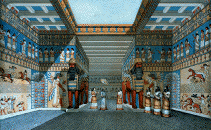
Mesopotamian, Palace of King Ashurnasirpal II of Assyria, Nimrud, Throne Room at Nimrud , c. 875 BCE, in a 19th century rendering. Painted lamassu flank the doorway. The walls bear painted limestone relief friezes.
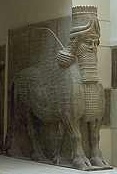
Mesopotamia, Khorsabad, Palace of Sargon of Assyria, 721-705 BCE, One of a Pair of Lamassu, gypseous alabaster, height 4.40 m, Louvre.
lamelia - A laminated material.
Also see metallic lamelia.
lamentation - See Pietà.
laminate - To build up a rigid surface
over a framework by applying layers of material,
adhering them to each other.
Laminating is a technique used
in sculpture with wood or ![]() resin. Plywood
is a laminated product, the wood grain going in a different direction with each layer, in order
to add strength. Corrugated cardboard and foam core (or foam board) are other laminated materials.
resin. Plywood
is a laminated product, the wood grain going in a different direction with each layer, in order
to add strength. Corrugated cardboard and foam core (or foam board) are other laminated materials.
![]()

Here are samples of Formica ®, a plastic
laminate often used as a surface on counters and other built-in
furniture.

Lamination
also commonly refers to the use of heat to adhere sheets of clear
plastic to one or both sides
of papers or cards.
Lamination is also a process of reinforcing fragile old paper, usually with thin, translucent or transparent sheets. Some forms this type of lamination are considered unacceptable to art conservators because of potential damage from high heat and pressure during application, instability of the lamination material, or difficulty in reversing the procedure, especially long after it has been accomplished.
Examples of laminates in the arts:

Alvar Aalto (Finnish, ), designer, manufacturer:
Artek, Finland, Paimio Chair, 1931-32, bent plywood,
bent laminated birch, and solid birch, 26 x 24 x 34 1/2 inches
(66 x 61 x 87.6 cm), Museum of Modern Art, NY. See design and furniture.

Lee Sinclair (British, contemporary), Laminated
Chair, 2000, ash with leather
cushion.
Also see adhesives, lamelia, swatch, and veneer.
land art - Earth art.
landscape architecture or landscape design - The decorative and functional modification and planting of grounds, especially at or around a building site.
Example:
A.-J. (Antoine Joseph) Dezallier d'Argenville
(French, 1680-1765), author; London : printed by George James,
1712, publisher, The Theory and Practice of Gardening : Wherein
is Fully Handled all that Relates to Fine Gardens,
Commonly called Pleasure-Gardens, as Parterres, Groves, Bowling-Greens &c. ...., 1712, printed book; [15] , 218 l [2] pages,
[28]  double leaves of plates,
[4] folding leaves of plates: illustrated; 26 cm, Metropolitan
Museum of Art, NY.
double leaves of plates,
[4] folding leaves of plates: illustrated; 26 cm, Metropolitan
Museum of Art, NY.
Illustrated:
Plate 4A: The general disposition of a garden of twelve acres
from The Theory and Practice of Gardening. See Baroque.
Quote:
Also see architecture, art careers, environment art, and topiary.
lantern - In architecture, a small, often decorative structure with openings to admit light and ventilation, crowning a dome, turret, or roof. Many a great dome built in the Italian Renaissance was topped with a lantern (lanterna in Italian).
Examples:

Filippo Brunelleschi (Italian, 1377-1446), Lantern atop the dome of Florence Cathedral, 1420-1434.

![]()

Michelangelo, Lantern atop the dome above the Medici Chapel of the Church of San Lorenzo, Florence, Italy. A view of the exterior of the lantern, and a view of the interior as seen from within the dome.
![]()

lapis - A bright blue stone containing golden specks, used in jewelry, intaglios, and decorative inlays and veneer. It is also the stone from which natural ultramarine pigment is ground, which was once widely used, but is now extremely expensive. Scientifically known as sodium aluminum silicate, until the nineteenth century it was obtained only from mines in what is now northeastern Afghanistan. The best lapis is called lapis lazuli.
(pr. LA-pə LA-zyoo-LI:)
lateral - Of, relating to, or situated at or on the side. Also, a lateral part, projection, passage, or appendage.
Also see balance and trabeation.
laterality - Awareness of one side of the body in relationship to space around it; a directional sense.
Also see balance.
latex - A rubbery substance used as binder in latex paints, as a cold cure molding compound, and also as the basis of certain adhesives. Although still used, latex has largely been replaced in many applications by silicon compounds and polyurethane plastics.
Examples:
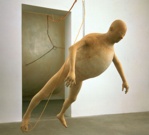
Tim Hawkinson (American, 1960-), Balloon Self-Portrait, 2004?, inflatable latex sculpture, life size, cast from the artist's body, turned inside out, then inflated by an air compressor, Ace Gallery, NYC. See self-portrait.



Cesar Martinez (Mexican, Mexico City, 1962-),
Aqui
estoy, 2001, inflatable
latex sculpture, life
size.
Also see gelatin.
Latin cross - A cross in which the vertical member is longer than the horizontal member.
lattice - A gridded openwork structure of crossed strips or bars of wood, metal, plastic, etc., used as a screen, support, etc. Or something resembling such a structure. Windows, doors, and gates are often screened by lattices. Graphs, curtain walls, and the grids in city and landscape architectural plans are often described as lattices.
(pr. LA-təs)
Lattices are among the ten classes of patterns.
Examples:
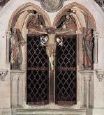
French, Choir screen with the Crucifixion at the Cathedral
at Naumburg, c. 1245, stone.
Inside a Gothic cathedral,
the nave was usually separated
from the choir by a large
stone choir screen, called a 'pulpitum' or 'jubé', which
excluded the lay public from the liturgy performed behind it.
The screens at Chartres and Amiens were later removed, but at
Naumburg a superbly carved
example from the middle of the thirteenth century has remained
intact.

India, Mughal;
found at / reportedly from Fatehpur Sikri, India, Jalee
screen, one of a pair, second half of the 16th century,
carved red sandstone,
73 1/4 x 51 3/16 x 3 9/16 inches (186 x 130 x 9 cm), Metropolitan
Museum of Art, NY. See jalee work.
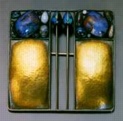
Josef Hoffmann (Austrian, 1870-1956) for
Wiener Werkstätte, Square Brooch, silver lattice, repoussé gold, and opal, c. 1905. See Art Nouveau, jewelry, opalescence, and secession.
Also see fenestration, rectilinear, and square.
lavoro di intarsia - See intarsia.
lawyer -
Quote:
lb. - Abbreviation for pound. Originally it stood for Libra, an ancient Roman unit of weight.
lead - A soft, malleable,
ductile, easily fusible, dull
medium-gray, dense metal used
in containers for corrosives, solder,
tire-ballancing weights, bullets,
and radiation shielding. Lead has been removed as a component
of pencils, house paints
(white lead) and much gasoline
because of its toxicity. Lead
was added to bronze alloys
by the ancient Chinese, by
the Etruscans,
and by the Romans, forming an alloy known as leaded bronze. Lead
was used also as the principal metal in some alloys used for cast sculpture
generally combined with tin
in making pewter, or with
antimony. Such sculpture often
requires an armature. Elemental
symbol Pb; atomic number 82; atomic weight 207.19; melting point
327.5°C; specific gravity 11.35; valence 2, 4. Also refers
to the grooved lead strips called came
used in making stained
glass.
(pr. led)
Examples of works produced in lead:
Aristide Maillol (French, 1861-1944), The Three Nymphs, 1930-8, cast 1937-8, lead, 157.5 x 146.7 x 80.6 cm, Tate Gallery, London. Maillol preferred the lead for this group because he felt that bronze would be too dark in character for the sculpture's theme.

Richard Serra (American, 1939-), Prop, 1968, lead antimony,
97 1/2 x 60 x 43 inches (247.7 x 152.4 x 109.2 cm), Whitney Museum
of American Art, NY. See Minimalism.
Related resource:
Also see antimony, graphite, lead glaze, leading, and poison.
lead glaze - A vitreous
coating applied for practical and ornamental
purposes to earthenware,
consisting of powder of lead oxide with silacious
sand, salt and potash which
fuses when fired.
It is transparent but color
can be added. Because of lead's toxicity, lead glazes must never
be used on surface which might
ever contact food, drink, or a mouth; and containers of lead glazes
must be labeled with such warnings. All glazes should be labeled
to reflect their lead and cadmium content. The following chart
describes six different types of ceramic glazes, each carrying
levels of concerns about lead content, in order to help you to
determine which are safe to
use on dinnerware — vessels for
food or drink.
|
A similar criterion should be followed whenever glazes contain the toxic element cadmium.
Also see ceramics, glaze, poison, and vessel.
leading - In typography, the horizontal spaces between lines of type, its thickness (height on a page) measured in points. Desk-top publishing software application programs employ this term (including Adobe FrameMaker, Adobe PageMaker, QuarkXpress, and Ventura Publisher), although some have incorrectly used it to mean the combined height of the leading plus an adjacent line of type. (If font is 12 points and leading is 2 points, for example, such programs mistakenly say you're using 14 points of leading). The term originated with the actual lead strips used with hand- and mechanically-aligned type. The space between characters side-to-side horizontally is called letter space.
(pr. LED-əng)
lead tin yellow - A particular yellow pigment.
Related resource:
leaf - Metal beaten into extremely thin sheets used especially for gilding. Leaf is traditionally made of gold or silver, but may be made of other metals, including aluminum, copper, and other less expensive ones which look like gold and silver. In a book, a leaf is a sheet of paper with, front-to-back (recto-to-verso), two pages.
Also see a chart of jewelry, ormolu, signature, and steel sheet gauges.
lean - When used to describe paint, signifies one with little oil in relation to pigment.
Also see fat and fat over lean.
leather-hard - In ceramics, a state in which clay has lost moisture to evaporation, but has not yet completely hardened; clay damp enough to be joined to other pieces with scoring and slip.
Also see greenware, krater, kylix, lekythos, vase, and vessel.
lectionary - In Christian tradition, a list, often illustrated, of lections — selections from the Bible that are read in church services.
left brain - Refers to a theory in which the left side of the brain is responsible for reading and verbal tasks, while the right brain is the creative side, responsible for art and spatial comprehension.
leitmotif - Originally a musical term, used to describe a device employed by composer Richard Wagner (German, 1813-1883). A specific musical phrase was associated with the first and each recurring appearance of a character, idea, or emotion. Then, by extension, a leitmotif came to have the general meaning of a recurring and often dominant theme in art, writing, or in life itself. Literally the German word means "leading or guiding motive."
(pr. LI:T-moh-TEEF)
lekythos - In ancient Greece, an oil jug with an ellipsoidal body, a narrow neck, a flanged mouth, a curved handle extending from below the lip to the shoulder, and a narrow base terminating in a foot. It was used chiefly for ointments and funerary offerings. Among the other types of Greek vases are the alabastron, amphora, hydria, kantharos, krater, kyathos, kylix, oinochoe, pelike, phiale, pinax, pithos, pyxis, and rhyton.
Examples:

Attributed to Douris (Greek, Athenian), Atalanta Lekythos, 1st half fifth century
BCE,
painted white-ground
terra cotta, 500-490 BCE,
height 31.8 cm, Cleveland Museum
of Art.

Greece, Attic, attributed to the Amasis Painter,
Lekythos, c. 550-530 BCE,
black-figure, terra
cotta, height 6 3/4 inches
(17.15 cm), Metropolitan Museum of Art, NY.
Greece, Attic, White-Ground Lekythos With Funerary Scene, attibuted to the Thanatos Painter, High Classical, c. 450 BCE, terra cotta, Michael C. Carlos Museum, Emory U, Atlanta, GA.

Greece, Attic, attributed to the Achilles
Painter, Lekythos, c. 440 BCE,
white-ground, terra cotta, height 14 3/4 inches (37.39 cm),
Metropolitan Museum of Art, NY. Depicted on this vase is a mourner
and the deceased at a tomb.

Xenophantos (Greek, Athens), Lekythos with Boar Hunt, c. 380 BCE,
clay, height
37 cm, State Hermitage Museum, St. Petersburg, Russia. The combination
of painting
and low relief, both molded and freely modeled, together with the polychromy
and overloaded composition
are characteristic of Athenian vessels
of the time of the decline of red-figure
painting.
lemon yellow - A particular yellow pigment.
Related resource:
length - Usually refers to the longest dimension. Synonyms for lengthwise are longtitudinal and axial.
Quote:
Also see angstrom, axial plan, depth, direction, font, height, longtitudinal, measure, nail, straight, type, typeface, text, thickness, and width.
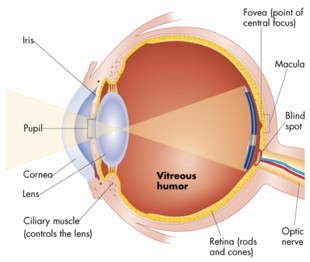
lens - Physically essential to sight, a transparent tissue that bends light passing through the eye. To focus light, the lens can change shape by bending. Also, a transparent piece of glass or another material, which is shaped to focus the passage of light through it and into or onto another surface in some other optical device, such as a camera, camera lucida, camera obscura, magnifying glass, telescope, microscope, mirror, projector, etc.
Examples:
Michelangelo (born Michelangiolo Buonarroti)
(Italian, 1475-1564), the left eye of David, 1501-04, marble,
entire statue 17 feet high, Galleria dell'Accademia, Florence.
The pupil was carved
not to represent its form, but to
 represent
its values. The sculptor has retained
a bit of marble inside the pupil in order to create a highlight.
A
represent
its values. The sculptor has retained
a bit of marble inside the pupil in order to create a highlight.
A detail
of David's head.
See colossal, detail,
Renaissance,
and sculpture.

Abelardo Morell (American, born Cuba, 1948-), Light Bulb, 1991, photograph of a camera obscura — a corrugated cardboard box fitted with a lens — so that light from a light bulb beside it is cast onto a wall of the box's interior. See transformation.
Also see blow-up, close-up, enlargement, field and field of view, filter, fish-eye lens, kaleidoscope, ophthalmology, refraction, sclera, telephoto, and wide-angle lens.
letterform - The shape of a letter (or character) of an alphabet, especially from the standpoint of its design or historical development — i.e., in calligraphy and typography. When one is interested in letterforms, one pays particular attention to those aspects of a letter's shape that differentiate it from the shapes of other letters, as in the nuances distinguishing an "O" from a "Q," a "g" from a "q," or an "E" from an "F." When a person writes or designs a letter, the degree to which that person honors the essence of the letterform of that character determines the letter's legibility.
Quote:
Also see distortion, graffiti, font, fontography, graphic design, ligature, logo, text, type, typeface, and typography.
letterhead - A heading which usually consists of
a name and an address (and often includes a monogram
or logo, and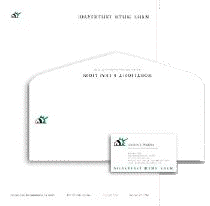 other design
elements, along with other text: street
/ postal, email, and Web addresses,
telephone numbers, tag line, and perhaps more) printed on a sheet of letter-writing paper. Although traditionally a "letterhead"
was at the top edge of a page,
it has become common for graphic
designers to place them along other edges, and even include
a faint image in the center
of a page. A letterhead can be vital to establishing the identity
of an organization or individual. As an important part of a unified
program to promote a client's goals, graphic designers often employ
variations on a client's letterhead in a system of designs placed
on envelopes, business cards, product packaging,
signage, advertising,
Web sites, etc. "Letterhead"
can also refer to full sheets of stationery imprinted with a heading.
other design
elements, along with other text: street
/ postal, email, and Web addresses,
telephone numbers, tag line, and perhaps more) printed on a sheet of letter-writing paper. Although traditionally a "letterhead"
was at the top edge of a page,
it has become common for graphic
designers to place them along other edges, and even include
a faint image in the center
of a page. A letterhead can be vital to establishing the identity
of an organization or individual. As an important part of a unified
program to promote a client's goals, graphic designers often employ
variations on a client's letterhead in a system of designs placed
on envelopes, business cards, product packaging,
signage, advertising,
Web sites, etc. "Letterhead"
can also refer to full sheets of stationery imprinted with a heading.
Also see ephemera, graphic design, and typography.
lettering - Drawing or creating letters used in words. To differentiate it from cursive writing, this action is sometimes referred to as printing. But the use of the term printing in this sense should be used cautiously, since it may be confused with its sense as a means of making multiply identical images.
Also see calligraphy, dingbat, dry transfer graphics, font, glyph, graphic design, hieroglyphics, icon, ideogram, leading, letter spacing (and kerning), logo, petroglyph, pictograph, text, type, typeface, and typography.
letter space - In typography, letter space is the placement or retention of space between characters. Kerning, by contrast, is the technique of adjusting the spacing between two letters to bring them close enough to overlap. The horizontal spaces between lines of type are called leading.
Also see alias, calligraphy, graphic design, lacuna, leading, lettering, text, type, and typeface.
levigation - Reduction of material to fine smooth paste or powder. Another (rarer!) term for this is trituration.
lexicon - A dictionary, especially of the terms of a particular profession or subject. The abbreviation for lexicon, lex., provided the last half of ArtPage, the title of the art reference you are reading right now.
Also see artlex, artlexicon, artlexical, artlexicographer, artlexicography, iconology, and iconography.
https://inform.quest/_art